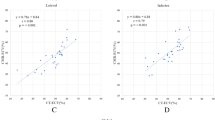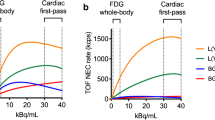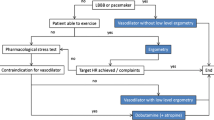Abstract
Object
This study has two objectives: (1) to compare the kinetics of low diffusion P846 with Gd-DOTA using inversion recovery echo planar (IR-EPI) magnetic resonance (MR) imaging and (2) to determine the potential of P846 in defining myocardial viability in hearts subjected to various injuries using T1-weighted spin echo (T1-SE).
Materials and methods
Rats were subjected to (1) occlusive infarcts (n = 16), (2) reperfused ischemic injuries (n = 8) or (3) reperfused infarcts (n = 16). A dose of 0.05 mmol/kg P846 was compared to 0.1 mmol/kg Gd-DOTA. IR-EPI and T1-SE images were obtained during 60 min. T1, ΔR1 and ΔR1 ratio were measured on IR-EPI. Infarct extents were evaluated on T1-SE and compared with histochemical staining.
Results
Blood ΔR1 was higher at 5 min after P846 (6.36 ± 0.32 s−1) than after Gd-DOTA (1.30 ± 0.14 s−1; P < 0.001). With P846, occlusive infarcts appeared as a hypoenhanced region surrounded by a hyperenhanced rim that lasted for 60 min. The increase in the ΔR1 ratio value was slower after P846 than with Gd-DOTA in the reperfused infarcts, suggesting low diffusion/convection of P846. Gd-DOTA homogenously enhanced both occlusive and reperfused infarcts at 30 min.
Conclusion
P846 provides better contrast and extended discrimination between occlusive and reperfused infarcts compared with Gd-DOTA. The gadolinium dose could be reduced with P846.
Similar content being viewed by others
References
Kaul P, Armstrong PW, Chang WC, Naylor CD, Granger CB, Lee KL, Peterson ED et al (2004) Long-term mortality of patients with acute myocardial infarction in the United States and Canada: comparison of patients enrolled in Global Utilization of Streptokinase and t-PA for Occluded Coronary Arteries (GUSTO)-I. Circulation 110: 1754–1760
Kim RJ, Fieno DS, Parrish TB, Harris K, Chen EL, Simonetti O, Bundy J et al (1999) Relationship of MRI delayed contrast enhancement to irreversible injury, infarct age, and contractile function. Circulation 100: 1992–2002
Simonetti OP, Kim RJ, Fieno DS, Hillenbrand HB, Wu E, Bundy JM, Finn JP et al (2001) An improved MR imaging technique for the visualization of myocardial infarction. Radiology 218: 215–223
Wellnhofer E, Olariu A, Klein C, Grafe M, Wahl A, Fleck E, Nagel E (2004) Magnetic resonance low-dose dobutamine test is superior to SCAR quantification for the prediction of functional recovery. Circulation 109: 2172–2174
Kraitchman DL, Hillenbrand HB, Oznur I, Lima JA, McVeigh ER, Zerhouni EA, Bluemke DA (2000) Noninvasive assessment of myocardial stunning from short-term coronary occlusion using tagged magnetic resonance imaging. J Cardiovasc Magn Reson 2: 123–136
Krombach GA, Wendland MF, Higgins CB, Saeed M (2002) MR imaging of spatial extent of microvascular injury in reperfused ischemically injured rat myocardium: value of blood pool ultrasmall superparamagnetic particles of iron oxide. Radiology 225: 479–486
Gerber BL, Rochitte CE, Melin JA, McVeigh ER, Bluemke DA, Wu KC, Becker LC et al (2000) Microvascular obstruction and left ventricular remodeling early after acute myocardial infarction. Circulation 101: 2734–2741
Choi KM, Kim RJ, Gubernikoff G, Vargas JD, Parker M, Judd RM (2001) Transmural extent of acute myocardial infarction predicts long-term improvement in contractile function. Circulation 104: 1101–1107
Arheden H, Saeed M, Higgins CB, Gao DW, Bremerich J, Wyttenbach R, Dae MW et al (1999) Measurement of the distribution volume of gadopentetate dimeglumine at echo-planar MR imaging to quantify myocardial infarction: comparison with 99mTc-DTPA autoradiography in rats. Radiology 211: 698–708
Shames DM, Kuwatsuru R, Vexler V, Muhler A, Brasch RC (1993) Measurement of capillary permeability to macromolecules by dynamic magnetic resonance imaging: a quantitative noninvasive technique. Magn Reson Med 29: 616–622
Wendland MF, Saeed M, Lauerma K, Derugin N, Mintorovitch J, Cavagna FM, Higgins CB (1997) Alterations in T1 of normal and reperfused infarcted myocardium after Gd-BOPTA versus GD-DTPA on inversion recovery EPI. Magn Reson Med 37: 448–456
Saeed M, Lee R, Martin A, Weber O, Krombach GA, Schalla S, Lee M et al (2004) Transendocardial delivery of extracellular myocardial markers by using combination X-ray/MR fluoroscopic guidance: feasibility study in dogs. Radiology 231: 689–696
Peldschus K, Hamdorf M, Robert P, Adam G, herborn C (2007) Preclinical evaluation of P846, a new high-relaxivity low diffusible gadolinium-based contrast agent, for contrast-enhancement MR angiography in rabbits at 1.5 T. International society for magnetic resonance in medicine abstract #969
Vautier J, Heilmann M, Dimicoli J, Volk A (2007) Characterization of an experimental setup to study in vitro permeability properties of macromolecular contrast agents by DCE-MRI. International society for magnetic resonance in medicine abstract #969
Port M (2002) Bicyclic polyaminoacid metal complexes, method preparing same and use in medical imaging. In: SA G.EP1183255Patent nο: EP20000940473 20000608
Bloembergen N, Morgan LO (1961) Proton relaxation times in paramagnetic solutions. Effects of Electron Spin Relaxation. J Chem Phys 34: 842–850
Solomon I (1955) Relaxation processes in a system of two spins. Phys Rev 99: 559–565
Laurent S, Elst LV, Muller RN (2006) Comparative study of the physicochemical properties of six clinical low molecular weight gadolinium contrast agents. Contrast Media Mol Imaging 1: 128–137
Kimura J, Ishiguchi T, Matsuda J, Ohno R, Nakamura A, Kamei S, Ohno K et al (2005) Human comparative study of zinc and copper excretion via urine after administration of magnetic resonance imaging contrast agents. Radiat Med 23: 322–326
Herborn CU, Honold E, Wolf M, Kemper J, Kinner S, Adam G, Barkhausen J (2007) Clinical safety and diagnostic value of the gadolinium chelate gadoterate meglumine (Gd-DOTA). Invest Radiol 42: 58–62
Arheden H, Saeed M, Higgins CB, Gao DW, Ursell PC, Bremerich J, Wyttenbach R et al (2000) Reperfused rat myocardium subjected to various durations of ischemia: estimation of the distribution volume of contrast material with echo-planar MR imaging. Radiology 215: 520–528
Jennings RB, Schaper J, Hill ML, Steenbergen C Jr, Reimer KA (1985) Effect of reperfusion late in the phase of reversible ischemic injury. Changes in cell volume, electrolytes, metabolites, and ultrastructure. Circ Res 56: 262–278
Saeed M, Lund G, Wendland MF, Bremerich J, Weinmann H, Higgins CB (2001) Magnetic resonance characterization of the peri-infarction zone of reperfused myocardial infarction with necrosis-specific and extracellular nonspecific contrast media. Circulation 103: 871–876
Krombach GA, Saeed M, Higgins CB, Novikov V, Wendland MF (2004) Contrast-enhanced MR delineation of stunned myocardium with administration of MnCl(2) in rats. Radiology 230: 183–190
Lund GK, Stork A, Saeed M, Bansmann MP, Gerken JH, Muller V, Mester J et al (2004) Acute myocardial infarction: evaluation with first-pass enhancement and delayed enhancement MR imaging compared with 201Tl SPECT imaging. Radiology 232: 49–57
Saeed M, Higgins CB, Geschwind JF, Wendland MF (2000) T1-relaxation kinetics of extracellular, intracellular and intravascular MR contrast agents in normal and acutely reperfused infarcted myocardium using echo-planar MR imaging. Eur Radiol 10: 310–318
Kim RJ, Chen EL, Lima JA, Judd RM (1996) Myocardial Gd-DTPA kinetics determine MRI contrast enhancement and reflect the extent and severity of myocardial injury after acute reperfused infarction. Circulation 94: 3318–3326
Judd RM, Lugo-Olivieri CH, Arai M, Kondo T, Croisille P, Lima JA, Mohan V et al (1995) Physiological basis of myocardial contrast enhancement in fast magnetic resonance images of 2-day-old reperfused canine infarcts. Circulation 92: 1902–1910
Weinmann HJ, Brasch RC, Press WR, Wesbey GE (1984) Characteristics of gadolinium-DTPA complex: a potential NMR contrast agent. AJR Am J Roentgenol 142: 619–624
Wendland MF, Saeed M, Yu KK, Roberts TP, Lauerma K, Derugin N, Varadarajan J et al (1994) Inversion recovery EPI of bolus transit in rat myocardium using intravascular and extravascular gadolinium-based MR contrast media: dose effects on peak signal enhancement. Magn Reson Med 32: 319–329
Hedstrom E, Arheden H, Eriksson R, Johansson L, Ahlstrom H, Bjerner T (2006) Importance of perfusion in myocardial viability studies using delayed contrast-enhanced magnetic resonance imaging. J Magn Reson Imaging 24: 77–83
Wendland MF, Saeed M, Lund G, Higgins CB (1999) Contrast-enhanced MRI for quantification of myocardial viability. J Magn Reson Imaging 10: 694–702
Port M, Corot C, Raynal I, Dencausse A, Schaefer M, Rousseaux O, Simonot C et al (2002) P760: a new gadolinium complex characterized by a low rate of interstitial diffusion. Acad Radiol 9(Suppl 1): S17–19
Jacquier A, Higgins CB, Martin AJ, Do L, Saloner D, Saeed M (2007) Injection of adeno-associated viral vector encoding vascular endothelial growth factor gene in infarcted swine myocardium: MR measurements of left ventricular function and strain. Radiology 245: 196–205
Kraitchman DL, Heldman AW, Atalar E, Amado LC, Martin BJ, Pittenger MF, Hare JM et al (2003) In vivo magnetic resonance imaging of mesenchymal stem cells in myocardial infarction. Circulation 107: 2290–2293
Oshinski JN, Yang Z, Jones JR, Mata JF, French BA (2001) Imaging time after Gd-DTPA injection is critical in using delayed enhancement to determine infarct size accurately with magnetic resonance imaging. Circulation 104: 2838–2842
Marckmann P, Skov L, Rossen K, Heaf JG, Thomsen HS (2007) Case-control study of gadodiamide-related nephrogenic systemic fibrosis. Nephrol Dial Transplant 22: 3174–3178
Thomsen HS (2004) Gadolinium-based contrast media may be nephrotoxic even at approved doses. Eur Radiol 14: 1654–1656
Saeed M, Weber O, Lee R, Do L, Martin A, Saloner D, Ursell P et al (2006) Discrimination of myocardial acute and chronic (scar) infarctions on delayed contrast enhanced magnetic resonance imaging with intravascular magnetic resonance contrast media. J Am Coll Cardiol 48: 1961–1968
Thomas D, Dumont C, Pickup S, Misselwitz B, Zhou R, Horowitz J, Ferrari VA (2006) T1-weighted cine FLASH is superior to IR imaging of post-infarction myocardial viability at 4.7 T. J Cardiovasc Magn Reson 8: 345–352
Author information
Authors and Affiliations
Corresponding author
Additional information
Drs. Philippe Robert PhD, Claire Corot PhD are employees at Guerbet Group, Paris, France. Preliminary data were reported at the Joint Annual Meeting’s ISMRM-ESMRMB, Berlin, Germany, May 2007.
Rights and permissions
About this article
Cite this article
Jacquier, A., Bucknor, M., Do, L. et al. P846, a new gadolinium based low diffusion magnetic resonance contrast agent, in characterizing occlusive infarcts, reperfused ischemic myocardium and reperfused infarcts in rats. Magn Reson Mater Phy 21, 207–218 (2008). https://doi.org/10.1007/s10334-008-0112-8
Received:
Revised:
Accepted:
Published:
Issue Date:
DOI: https://doi.org/10.1007/s10334-008-0112-8




